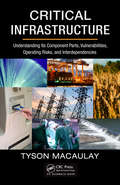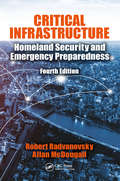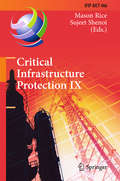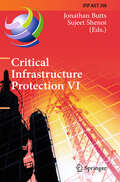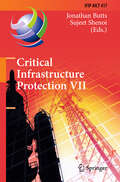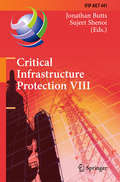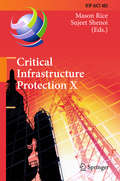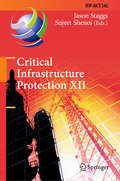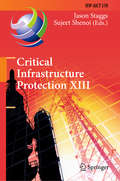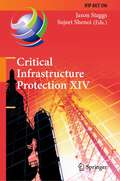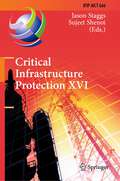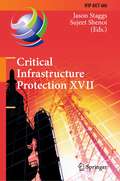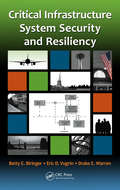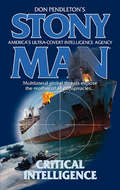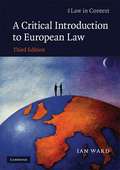- Table View
- List View
Critical Incident Management: A Complete Response Guide, Second Edition
by Vincent Faggiano John McNall Thomas T. GillespieTerrorism threats and increased school and workplace violence have always generated headlines, but in recent years, the response to these events has received heightened media scrutiny. Critical Incident Management: A Complete Resource Guide, Second Edition provides evidence-based, tested, and proven methodologies applicable to a host of scenarios t
Critical Incident Management
by Alan B. SterneckertMost businesses are aware of the danger posed by malicious network intruders and other internal and external security threats. Unfortunately, in many cases the actions they have taken to secure people, information and infrastructure from outside attacks are inefficient or incomplete. Responding to security threats and incidents requires a competent
Critical Incident Management
by Alan B. SterneckertMost businesses are aware of the danger posed by malicious network intruders and other internal and external security threats. Unfortunately, in many cases the actions they have taken to secure people, information and infrastructure from outside attacks are inefficient or incomplete. Responding to security threats and incidents requires a competent
Critical Indigenous Rights Studies (Routledge Research in Human Rights Law)
by Giselle Corradi Koen De Feyter Ellen Desmet Katrijn VanheesThe field of ‘critical indigenous rights studies’ is a complex one that benefits from an interdisciplinary perspective and a realist (as opposed to an idealised) approach to indigenous peoples. This book draws on sociology of law, anthropology, political sciences and legal sciences in order to address emerging issues in the study of indigenous rights and identify directions for future research. The first part of the volume investigates how changing identities and cultures impact rights protection, analysing how policies on development and land, and processes such as migration, interrelate with the mobilisation of identities and the realisation of rights. In the second part, new approaches related to indigenous peoples’ rights are scrutinised as to their potential and relevance. They include addressing legal tensions from an indigenous peoples’ rights perspective, creating space for counter-narratives on international law and designing new instruments. Throughout the text, case studies with wide geographical scope are presented, ranging from Latin America (the book’s focus) to Egypt, Rwanda and Scandinavia.
Critical Indigenous Rights Studies (Routledge Research in Human Rights Law)
by Giselle Corradi Koen De Feyter Ellen Desmet Katrijn VanheesThe field of ‘critical indigenous rights studies’ is a complex one that benefits from an interdisciplinary perspective and a realist (as opposed to an idealised) approach to indigenous peoples. This book draws on sociology of law, anthropology, political sciences and legal sciences in order to address emerging issues in the study of indigenous rights and identify directions for future research. The first part of the volume investigates how changing identities and cultures impact rights protection, analysing how policies on development and land, and processes such as migration, interrelate with the mobilisation of identities and the realisation of rights. In the second part, new approaches related to indigenous peoples’ rights are scrutinised as to their potential and relevance. They include addressing legal tensions from an indigenous peoples’ rights perspective, creating space for counter-narratives on international law and designing new instruments. Throughout the text, case studies with wide geographical scope are presented, ranging from Latin America (the book’s focus) to Egypt, Rwanda and Scandinavia.
Critical Information Infrastructures Security: 12th International Conference, CRITIS 2017, Lucca, Italy, October 8-13, 2017, Revised Selected Papers (Lecture Notes in Computer Science #10707)
by Gregorio D’Agostino Antonio ScalaThis book constitutes revised selected papers from the 12th International Conference on Critical Information Infrastructures Security, CRITIS 201, held in Lucca, Italy, in October 2017. The 21 full papers and 4 short papers presented were carefully reviewed and selected from 63 submissions. They present innovative research and explore new challenges in the field of critical information infrastructures protection (C(I)IP) and deal with multi-disciplinary approaches to relevant C(I)IP problems.
Critical Information Infrastructures Security: 11th International Conference, CRITIS 2016, Paris, France, October 10–12, 2016, Revised Selected Papers (Lecture Notes in Computer Science #10242)
by Grigore Havarneanu Roberto Setola Hypatia Nassopoulos Stephen WolthusenThis book constitutes the post-conference proceedings of the 11th International Conference on Critical Information Infrastructures Security, CRITIS 2016, held in Paris, France, in October 2016. The 22 full papers and 8 short papers presented were carefully reviewed and selected from 58 submissions. They present the most recent innovations, trends, results, experiences and concerns in selected perspectives of critical information infrastructure protection covering the range from small-scale cyber-physical systems security via information infrastructures and their interaction with national and international infrastructures.
Critical Information Infrastructures Security: 13th International Conference, CRITIS 2018, Kaunas, Lithuania, September 24-26, 2018, Revised Selected Papers (Lecture Notes in Computer Science #11260)
by Eric Luiijf Inga Žutautaitė Bernhard M. HämmerliThis book constitutes revised selected papers from the 13th International Conference on Critical Information Infrastructures Security, CRITIS 2018, held in Kaunas, Lithuania, in September 2018.The 16 full papers and 3 short papers presented were carefully reviewed and selected from 61 submissions. They are grouped in the following topical sections: advanced analysis of critical energy systems, strengthening urban resilience, securing internet of things and industrial control systems, need and tool sets for industrial control system security, and advancements in governance and resilience of critical infrastructures.
Critical Infrastructure: Understanding Its Component Parts, Vulnerabilities, Operating Risks, and Interdependencies
by Tyson MacaulayCritical Infrastructure (CI) is fundamental to the functioning of a modern economy, and consequently, maintaining CI security is paramount. However, despite all the security technology available for threats and risks to CI, this crucial area often generates more fear than rational discussion. Apprehension unfortunately prompts many involved in CI p
Critical Infrastructure: Homeland Security and Emergency Preparedness, Fourth Edition
by Robert S. Radvanovsky Allan McDougallThis edition of Critical Infrastructure presents a culmination of ongoing research and real-work experience, building upon previous editions. Since the first edition of this work, the domain has seen significant evolutions in terms of operational needs, environmental challenges and threats – both emerging and evolving. This work expands upon the previous works and maintains its focus on those efforts vital to securing the safety and security of populations. The world continues to see a shift from a force-protection model to one more focused on resilience. This process has been exacerbated and challenged as societies face increased instability in weather and arguably climate, a destabilized geopolitical situation, and continuing economic instability. Various levels—ranging from international oversight to individual actions—continue to work towards new approaches and tools that can assist in meeting this challenge. This work keeps pace with the key changes that have occurred since previous editions and continues to provide insight into emerging and potential issues. Expanding from historical research, major areas of interest such as climate change, regulatory oversight, and internal capacity building are explored. This work provides a reference for those that are working to prepare themselves and their organizations for challenges likely to arise over the next decade. In keeping with the fast-changing nature of this field, Critical Infrastructure: Homeland Security and Emergency Preparedness, Fourth Edition has been completely revised and fully updated to reflect this shift in focus and to incorporate the latest developments. Presents an overview of some of the emerging challenges and conflicts between the public and private sector; Continues to build the case for organizations to adopt an intelligence-driven and adaptive approach to protecting infrastructure; Presents a unique and new perspective of re-examining baseline requirements against a range of shifting factors, taking a balanced approach between risk-based planning and consequence management; Expands upon the issue of internal and lone-wolf threats that pose additional challenges to a system that continues to focus largely on external threats; and An enhanced and improved view of interdependencies in an increasingly inter-connected and network-enabled world. Preparing for the challenges of increasingly unstable threat and operating environments will pose challenges at all levels. Those involved in ensuring that critical infrastructure protection and assurance efforts function effectively and efficiently—whether as government regulators, business operators, clients of various infrastructure sectors or those seeking to maintain an accountable system – will find insights into less-explored aspects of this challenging field.
Critical Infrastructure: Homeland Security and Emergency Preparedness, Fourth Edition
by Robert S. Radvanovsky Allan McDougallThis edition of Critical Infrastructure presents a culmination of ongoing research and real-work experience, building upon previous editions. Since the first edition of this work, the domain has seen significant evolutions in terms of operational needs, environmental challenges and threats – both emerging and evolving. This work expands upon the previous works and maintains its focus on those efforts vital to securing the safety and security of populations. The world continues to see a shift from a force-protection model to one more focused on resilience. This process has been exacerbated and challenged as societies face increased instability in weather and arguably climate, a destabilized geopolitical situation, and continuing economic instability. Various levels—ranging from international oversight to individual actions—continue to work towards new approaches and tools that can assist in meeting this challenge. This work keeps pace with the key changes that have occurred since previous editions and continues to provide insight into emerging and potential issues. Expanding from historical research, major areas of interest such as climate change, regulatory oversight, and internal capacity building are explored. This work provides a reference for those that are working to prepare themselves and their organizations for challenges likely to arise over the next decade. In keeping with the fast-changing nature of this field, Critical Infrastructure: Homeland Security and Emergency Preparedness, Fourth Edition has been completely revised and fully updated to reflect this shift in focus and to incorporate the latest developments. Presents an overview of some of the emerging challenges and conflicts between the public and private sector; Continues to build the case for organizations to adopt an intelligence-driven and adaptive approach to protecting infrastructure; Presents a unique and new perspective of re-examining baseline requirements against a range of shifting factors, taking a balanced approach between risk-based planning and consequence management; Expands upon the issue of internal and lone-wolf threats that pose additional challenges to a system that continues to focus largely on external threats; and An enhanced and improved view of interdependencies in an increasingly inter-connected and network-enabled world. Preparing for the challenges of increasingly unstable threat and operating environments will pose challenges at all levels. Those involved in ensuring that critical infrastructure protection and assurance efforts function effectively and efficiently—whether as government regulators, business operators, clients of various infrastructure sectors or those seeking to maintain an accountable system – will find insights into less-explored aspects of this challenging field.
Critical Infrastructure Protection IX: 9th IFIP 11.10 International Conference, ICCIP 2015, Arlington, VA, USA, March 16-18, 2015, Revised Selected Papers (IFIP Advances in Information and Communication Technology #466)
by Mason Rice Sujeet ShenoiThe information infrastructure---comprising computers, embedded devices, networks and software systems---is vital to day-to-day operations in every sector: information and telecommunications, banking and finance, energy, chemicals and hazardous materials, agriculture, food, water, public health, emergency services, transportation, postal and shipping, government and defense. Global business and industry, governments, indeed society itself, cannot function effectively if major components of the critical information infrastructure are degraded, disabled or destroyed. Critical Infrastructure Protection describes original research results and innovative applications in the interdisciplinary field of critical infrastructure protection. Also, it highlights the importance of weaving science, technology and policy in crafting sophisticated, yet practical, solutions that will help secure information, computer and network assets in the various critical infrastructure sectors. Areas of coverage include: Themes and Issues, Control Systems Security, Cyber-Physical Systems Security, Infrastructure Security, Infrastructure Modeling and Simulation, Risk and Impact Assessment. This book is the ninth volume in the annual series produced by the International Federation for Information Processing (IFIP) Working Group 11.10 on Critical Infrastructure Protection, an international community of scientists, engineers, practitioners and policy makers dedicated to advancing research, development and implementation efforts focused on infrastructure protection. The book contains a selection of nineteen edited papers from the Ninth Annual IFIP WG 11.10 International Conference on Critical Infrastructure Protection, held at SRI International, Arlington, Virginia, USA in the spring of 2015. Critical Infrastructure Protection IX is an important resource for researchers, faculty members and graduate students, as well as for policy makers, practitioners and other individuals with interests in homeland security. Mason Rice is an Assistant Professor of Computer Science at the Air Force Institute of Technology, Wright-Patterson Air Force Base, Ohio, USA. Sujeet Shenoi is the F.P. Walter Professor of Computer Science and a Professor of Chemical Engineering at the University of Tulsa, Tulsa, Oklahoma, USA.
Critical Infrastructure Protection VI: 6th IFIP WG 11.10 International Conference, ICCIP 2012, Washington, DC, USA, March 19-21, 2012, Revised Selected Papers (IFIP Advances in Information and Communication Technology #390)
by Jonathan Butts Sujeet ShenoiThe information infrastructure - comprising computers, embedded devices, networks and software systems - is vital to day-to-day operations in every sector: information and telecommunications, banking and finance, energy, chemicals and hazardous materials, agriculture, food, water, public health, emergency services, transportation, postal and shipping, government and defense. Global business and industry, governments, indeed society itself, cannot function effectively if major components of the critical information infrastructure are degraded, disabled or destroyed. Critical Infrastructure Protection VI describes original research results and innovative applications in the interdisciplinary field of critical infrastructure protection. Also, it highlights the importance of weaving science, technology and policy in crafting sophisticated, yet practical, solutions that will help secure information, computer and network assets in the various critical infrastructure sectors. Areas of coverage includes: Themes and Issues; Control Systems Security; Infrastructure Security; and Infrastructure Modeling and Simulation. This book is the sixth volume in the annual series produced by the International Federation for Information Processing (IFIP) Working Group 11.10 on Critical Infrastructure Protection, an international community of scientists, engineers, practitioners and policy makers dedicated to advancing research, development and implementation efforts focused on infrastructure protection. The book contains a selection of sixteen edited papers from the Sixth Annual IFIP WG 11.10 International Conference on Critical Infrastructure Protection, held at the National Defense University, Washington, DC, USA in the spring of 2011. Critical Infrastructure Protection VI is an important resource for researchers, faculty members and graduate students, as well as for policy makers, practitioners and other individuals with interests in homeland security. Jonathan Butts is an Assistant Professor of Computer Science at the Air Force Institute of Technology, Wright-Patterson Air Force Base, Ohio, USA. Sujeet Shenoi is the F.P. Walter Professor of Computer Science and a Professor of Chemical Engineering at the University of Tulsa, Tulsa, Oklahoma, USA.
Critical Infrastructure Protection VII: 7th IFIP WG 11.10 International Conference, ICCIP 2013, Washington, DC, USA, March 18-20, 2013, Revised Selected Papers (IFIP Advances in Information and Communication Technology #417)
by Jonathan Butts Sujeet ShenoiThe information infrastructure - comprising computers, embedded devices, networks and software systems - is vital to day-to-day operations in every sector: information and telecommunications, banking and finance, energy, chemicals and hazardous materials, agriculture, food, water, public health, emergency services, transportation, postal and shipping, government and defense. Global business and industry, governments, indeed society itself, cannot function effectively if major components of the critical information infrastructure are degraded, disabled or destroyed. Critical Infrastructure Protection VII describes original research results and innovative applications in the interdisciplinary field of critical infrastructure protection. Also, it highlights the importance of weaving science, technology and policy in crafting sophisticated, yet practical, solutions that will help secure information, computer and network assets in the various critical infrastructure sectors. Areas of coverage include: themes and issues; control systems security; infrastructure security; infrastructure modeling and simulation; and risk assessment. This book is the seventh volume in the annual series produced by the International Federation for Information Processing (IFIP) Working Group 11.10 on Critical Infrastructure Protection, an international community of scientists, engineers, practitioners and policy makers dedicated to advancing research, development and implementation efforts focused on infrastructure protection. The book contains a selection of fifteen edited papers from the Seventh Annual IFIP WG 11.10 International Conference on Critical Infrastructure Protection, held at George Washington University, Washington, DC, USA in the spring of 2013. Critical Infrastructure Protection VII is an important resource for researchers, faculty members and graduate students, as well as for policy makers, practitioners and other individuals with interests in homeland security. Jonathan Butts is an Assistant Professor of Computer Science at the Air Force Institute of Technology, Wright-Patterson Air Force Base, Ohio, USA. Sujeet Shenoi is the F.P. Walter Professor of Computer Science and a Professor of Chemical Engineering at the University of Tulsa, Tulsa, Oklahoma, USA.
Critical Infrastructure Protection VIII: 8th IFIP WG 11.10 International Conference, ICCIP 2014, Arlington, VA, USA, March 17-19, 2014, Revised Selected Papers (IFIP Advances in Information and Communication Technology #441)
by Jonathan Butts Sujeet ShenoiThe information infrastructure - comprising computers, embedded devices, networks and software systems - is vital to day-to-day operations in every sector: information and telecommunications, banking and finance, energy, chemicals and hazardous materials, agriculture, food, water, public health, emergency services, transportation, postal and shipping, government and defense. Global business and industry, governments, indeed society itself, cannot function effectively if major components of the critical information infrastructure are degraded, disabled or destroyed. Critical Infrastructure Protection VIII describes original research results and innovative applications in the interdisciplinary field of critical infrastructure protection. Also, it highlights the importance of weaving science, technology and policy in crafting sophisticated, yet practical, solutions that will help secure information, computer and network assets in the various critical infrastructure sectors. Areas of coverage include: control systems security, infrastructure security, infrastructure modeling and simulation, risk and impact assessment, and advanced techniques. This book is the eighth volume in the annual series produced by the International Federation for Information Processing (IFIP) Working Group 11.10 on Critical Infrastructure Protection, an international community of scientists, engineers, practitioners and policy makers dedicated to advancing research, development and implementation efforts focused on infrastructure protection. The book contains a selection of seventeen edited papers from the 8th Annual IFIP WG 11.10 International Conference on Critical Infrastructure Protection, held at SRI International, Arlington, Virginia, DC, USA in the spring of 2014. Critical Infrastructure Protection VIII is an important resource for researchers, faculty members and graduate students, as well as for policy makers, practitioners and other individuals with interests in homeland security.
Critical Infrastructure Protection X: 10th IFIP WG 11.10 International Conference, ICCIP 2016, Arlington, VA, USA, March 14-16, 2016, Revised Selected Papers (IFIP Advances in Information and Communication Technology #485)
The information infrastructure - comprising computers, embedded devices, networks and software systems - is vital to day-to-day operations in every sector: information and telecommunications, banking and finance, energy, chemicals and hazardous materials, agriculture, food, water, public health, emergency services, transportation, postal and shipping, government and defense. Global business and industry, governments, indeed society itself, cannot function effectively if major components of the critical information infrastructure are degraded, disabled or destroyed. Critical Infrastructure Protection describes original research results and innovative applications in the interdisciplinary field of critical infrastructure protection. Also, it highlights the importance of weaving science, technology and policy in crafting sophisticated, yet practical, solutions that will help secure information, computer and network assets in the various critical infrastructure sectors. Areas of coverage include: themes and issues; control systems security; infrastructure modeling and simulation; risk and impact assessment. This book is the tenth volume in the annual series produced by the International Federation for Information Processing (IFIP) Working Group 11.10 on Critical Infrastructure Protection, an international community of scientists, engineers, practitioners and policy makers dedicated to advancing research, development and implementation efforts focused on infrastructure protection. The book contains a selection of fourteen edited papers from the Tenth Annual IFIP WG 11.10 International Conference on Critical Infrastructure Protection, held at SRI International, Arlington, Virginia, USA in the spring of 2016. Critical Infrastructure Protection is an important resource for researchers, faculty members and graduate students, as well as for policy makers, practitioners and other individuals with interests in homeland security.
Critical Infrastructure Protection XII: 12th IFIP WG 11.10 International Conference, ICCIP 2018, Arlington, VA, USA, March 12-14, 2018, Revised Selected Papers (IFIP Advances in Information and Communication Technology #542)
by Jason Staggs Sujeet ShenoiThe information infrastructure – comprising computers, embedded devices, networks and software systems – is vital to operations in every sector: chemicals, commercial facilities, communications, critical manufacturing, dams, defense industrial base, emergency services, energy, financial services, food and agriculture, government facilities, healthcare and public health, information technology, nuclear reactors, materials and waste, transportation systems, and water and wastewater systems. Global business and industry, governments, indeed society itself, cannot function if major components of the critical information infrastructure are degraded, disabled or destroyed. Critical Infrastructure Protection XII describes original research results and innovative applications in the interdisciplinary field of critical infrastructure protection. Also, it highlights the importance of weaving science, technology and policy in crafting sophisticated, yet practical, solutions that will help secure information, computer and network assets in the various critical infrastructure sectors. Areas of coverage include: Themes and Issues; Infrastructure Protection; Infrastructure Modeling and Simulation; Industrial Control Systems Security. This book is the twelfth volume in the annual series produced by the International Federation for Information Processing (IFIP) Working Group 11.10 on Critical Infrastructure Protection, an international community of scientists, engineers, practitioners and policy makers dedicated to advancing research, development and implementation efforts focused on infrastructure protection. The book contains a selection of fifteen edited papers from the Twelfth Annual IFIP WG 11.10 International Conference on Critical Infrastructure Protection, held at SRI International, Arlington, Virginia, USA in the spring of 2018. Critical Infrastructure Protection XII is an important resource for researchers, faculty members and graduate students, as well as for policy makers, practitioners and other individuals with interests in homeland security.
Critical Infrastructure Protection XIII: 13th IFIP WG 11.10 International Conference, ICCIP 2019, Arlington, VA, USA, March 11–12, 2019, Revised Selected Papers (IFIP Advances in Information and Communication Technology #570)
The information infrastructure – comprising computers, embedded devices, networks and software systems – is vital to operations in every sector: chemicals, commercial facilities, communications, critical manufacturing, dams, defense industrial base, emergency services, energy, financial services, food and agriculture, government facilities, healthcare and public health, information technology, nuclear reactors, materials and waste, transportation systems, and water and wastewater systems. Global business and industry, governments, indeed society itself, cannot function if major components of the critical information infrastructure are degraded, disabled or destroyed. Critical Infrastructure Protection XIII describes original research results and innovative applications in the interdisciplinary field of critical infrastructure protection. Also, it highlights the importance of weaving science, technology and policy in crafting sophisticated, yet practical, solutions that will help secure information, computer and network assets in the various critical infrastructure sectors. Areas of coverage include: Themes and Issues; Infrastructure Protection; Vehicle Infrastructure Security; Telecommunications Infrastructure Security; Cyber-Physical Systems Security; and Industrial Control Systems Security. This book is the thirteenth volume in the annual series produced by the International Federation for Information Processing (IFIP) Working Group 11.10 on Critical Infrastructure Protection, an international community of scientists, engineers, practitioners and policy makers dedicated to advancing research, development and implementation efforts focused on infrastructure protection. The book contains a selection of sixteen edited papers from the Thirteenth Annual IFIP WG 11.10 International Conference on Critical Infrastructure Protection, held at SRI International, Arlington, Virginia, USA in the spring of 2019. Critical Infrastructure Protection XIII is an important resource for researchers, faculty members and graduate students, as well as for policy makers, practitioners and other individuals with interests in homeland security.
Critical Infrastructure Protection XIV: 14th IFIP WG 11.10 International Conference, ICCIP 2020, Arlington, VA, USA, March 16–17, 2020, Revised Selected Papers (IFIP Advances in Information and Communication Technology #596)
The information infrastructure – comprising computers, embedded devices, networks and software systems – is vital to operations in every sector: chemicals, commercial facilities, communications, critical manufacturing, dams, defense industrial base, emergency services, energy, financial services, food and agriculture, government facilities, healthcare and public health, information technology, nuclear reactors, materials and waste, transportation systems, and water and wastewater systems. Global business and industry, governments, indeed society itself, cannot function if major components of the critical information infrastructure are degraded, disabled or destroyed.Critical Infrastructure Protection XIV describes original research results and innovative applications in the interdisciplinary field of critical infrastructure protection. Also, it highlights the importance of weaving science, technology and policy in crafting sophisticated, yet practical, solutions that will help secure information, computer and network assets in the various critical infrastructure sectors. Areas of coverage include: Aviation Infrastructure Security; Vehicle Infrastructure Security; Telecommunications Systems Security; Industrial Control Systems Security; Cyber-Physical Systems Security; and Infrastructure Modeling and Simulation. This book is the fourteenth volume in the annual series produced by the International Federation for Information Processing (IFIP) Working Group 11.10 on Critical Infrastructure Protection, an international community of scientists, engineers, practitioners and policy makers dedicated to advancing research, development and implementation efforts focused on infrastructure protection. The book contains a selection of sixteen edited papers from the Fourteenth Annual IFIP WG 11.10 International Conference on Critical Infrastructure Protection, held at SRI International, Arlington, Virginia, USA in the spring of 2020. Critical Infrastructure Protection XIV is an important resource for researchers, faculty members and graduate students, as well as for policy makers, practitioners and other individuals with interests in homeland security.
Critical Infrastructure Protection XVI: 16th IFIP WG 11.10 International Conference, ICCIP 2022, Virtual Event, March 14–15, 2022, Revised Selected Papers (IFIP Advances in Information and Communication Technology #666)
The information infrastructure – comprising computers, embedded devices, networks and software systems – is vital to operations in every sector: chemicals, commercial facilities, communications, critical manufacturing, dams, defense industrial base, emergency services, energy, financial services, food and agriculture, government facilities, healthcare and public health, information technology, nuclear reactors, materials and waste, transportation systems, and water and wastewater systems. Global business and industry, governments, indeed society itself, cannot function if major components of the critical information infrastructure are degraded, disabled or destroyed.Critical Infrastructure Protection XVI describes original research results and innovative applications in the interdisciplinary field of critical infrastructure protection. Also, it highlights the importance of weaving science, technology and policy in crafting sophisticated, yet practical, solutions that will help secure information, computer and network assets in the various critical infrastructure sectors. Areas of coverage include: Industrial Control Systems Security; Telecommunications Systems Security; Infrastructure Security.This book is the 16th volume in the annual series produced by the International Federation for Information Processing (IFIP) Working Group 11.10 on Critical Infrastructure Protection, an international community of scientists, engineers, practitioners and policy makers dedicated to advancing research, development and implementation efforts focused on infrastructure protection. The book contains a selection of 11 edited papers from the Fifteenth Annual IFIP WG 11.10 International Conference on Critical Infrastructure Protection, held as a virtual event during March, 2022.Critical Infrastructure Protection XVI is an important resource for researchers, faculty members and graduate students, as well as for policy makers, practitioners and other individuals with interests in homeland security.
Critical Infrastructure Protection XVII: 17th IFIP WG 11.10 International Conference, ICCIP 2023, Arlington, VA, USA, March 13–14, 2023, Revised Selected Papers (IFIP Advances in Information and Communication Technology #686)
by Jason Staggs Sujeet ShenoiThe information infrastructure – comprising computers, embedded devices, networks and software systems – is vital to operations in every sector: chemicals, commercial facilities, communications, critical manufacturing, dams, defense industrial base, emergency services, energy, financial services, food and agriculture, government facilities, healthcare and public health, information technology, nuclear reactors, materials and waste, transportation systems, and water and wastewater systems. Global business and industry, governments, indeed society itself, cannot function if major components of the critical information infrastructure are degraded, disabled or destroyed. Critical Infrastructure Protection XVII describes original research results and innovative applications in the interdisciplinary field of critical infrastructure protection. Also, it highlights the importance of weaving science, technology and policy in crafting sophisticated, yet practical, solutions that will help secure information, computer and network assets in the various critical infrastructure sectors. Areas of coverage include: Themes and IssuesSmart Grid Risks and ImpactsNetwork and Telecommunications Systems SecurityInfrastructure SecurityAutomobile Security This book is the seventeenth volume in the annual series produced by the International Federation for Information Processing (IFIP) Working Group 11.10 on Critical Infrastructure Protection, an international community of scientists, engineers, practitioners and policy makers dedicated to advancing research, development and implementation efforts focused on infrastructure protection. The book contains a selection of eleven edited papers from the Seventeenth Annual IFIP WG 11.10 International Conference on Critical Infrastructure Protection, which was held at SRI International, Arlington, Virginia, USA in the spring of 2023. Critical Infrastructure Protection XVII is an important resource for researchers, faculty members and graduate students, as well as for as well as for policy makers, practitioners and other individuals with interests in homeland security.
Critical Infrastructure System Security and Resiliency
by Betty Biringer Eric Vugrin Drake WarrenSecurity protections for critical infrastructure nodes are intended to minimize the risks resulting from an initiating event, whether it is an intentional malevolent act or a natural hazard. With an emphasis on protecting an infrastructure's ability to perform its mission or function, Critical Infrastructure System Security and Resiliency presents
Critical Insights on Colonial Modes of Seeing Cattle in India: Tracing the Pre-history of Green and White Revolutions (Asia in Transition #27)
by Himanshu UpadhyayaThis book traces the contours of the symbiotic relationship between crop cultivation and cattle rearing in India by reading against the grain of several official accounts from the late colonial period to the 1980s. It also skillfully unpacks the multiple cultural expressions that revolve around cattle in India and the wider subcontinent to show how this domestic animal has greatly impacted political discourses in South Asia from colonial times, into the postcolonial period. The author begins by demonstrating the dependence between the nomadic cattle breeder and the settled cultivator, at the nexus of land-livestock-agriculture, as indicated in the writings of Sir Albert Howard, who espoused some of the most sophisticated ideas on integration, holism, and mixed farming in an era when agricultural research was marked by increasing specialisation and compartmentalisation. The book springboards with the views of colonial experts who worked at imperial science institutions but passionately voiced dissenting opinions due to their emotional investment in the lives of Indian peasants, of whom Howard was a leading light. The book presents Howard and his contemporaries’ writings to then engage contemporary debates surrounding organic agriculture and climate change, tracing the path out of the treadmill of industrial agriculture and factory farming. In doing so, the book shows how, historically, animal rearing has been critically linked to livelihood strategies in the Indian subcontinent. At once a dispassionate reflection on the role played by cattle and water buffaloes in not just supporting farm operations in the agro-pastoral landscape, but also in contributing to millions of livelihoods in sustainable ways while fulfilling the animal protein in the Indian diet, the book presents contemporary lessons on development perspectives relating to sustainable and holistic agriculture. A rich and sweeping treatment of this aspect of environmental history in India that tackles the transformations prompted by the arrival of veterinary medicine, veterinary education and notions of scientific livestock management, the book is a rare read for historians, environmentalists, agriculturalists, development practitioners, and animal studies scholars with a particular interest in South Asia.
Critical Intelligence
by Don PendletonOperating under covert presidential directive, the clandestine antiterrorist organization Stony Man doesn't officially exist. Unofficially, they fight the fires bureaucracy can't or won't touch.
A Critical Introduction To European Law (PDF)
by Ian WardWritten by one of the leading academics specialising in European law and legal theory, A Critical Introduction to European Law explains the history and institutional framework of European Union law to students and scholars. Through the inclusion of commentaries on successive drafts of the Constitutional and Lisbon treaties, and discussion of recent developments such as the Turkish application, this third edition explores the evolving role of the EU in international and global politics. A consciously interdisciplinary approach, which draws on a variety of materials from political and legal thought, social theory, economic analysis, literature, history and cultural studies, is deployed to make the present state of Union law comprehensible.






